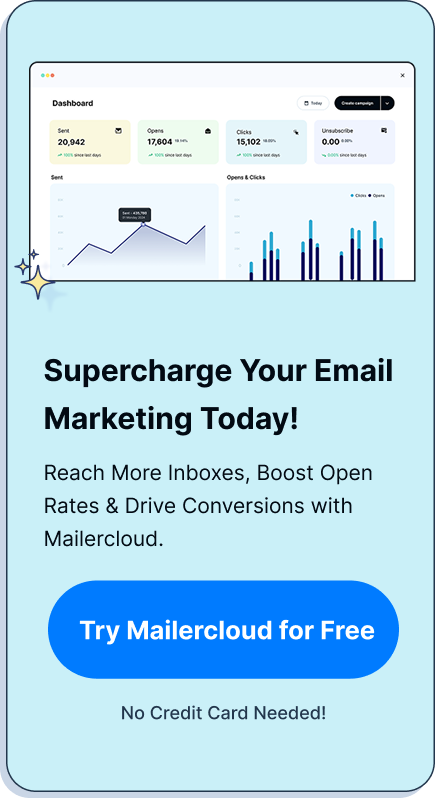CTA in email marketing works more like the finale of a gripping story mentioned in the email body. What happens at the story’s climax determines the story’s success. This is also how email conversions work. The grand finale of the email conversion riddle is to give the recipients a persuasive reason to click. CTAs drive the conversion rates and marketing ROI of the campaigns.
The appropriate CTA in emails can bridge the gap between expectations and allow subscribers to perform the required action on the email.
Table of Contents
Fundamentals of CTA in Email Marketing
A CTA in email marketing is a button or hyperlinked line of text that directs a user from the email to a brand’s website or specific landing page. CTAs are used by marketers to get recipients to do more than just read the email. The goal of a CTA is to get the email recipients to take action. Depending on the email’s purpose, CTAs might lead to a range of various actions. A CTA in emails is most visible, enticing, and hard to miss.
CTAs can help in fulfilling the following goals:
- Lead generation
- Social sharing
- Sales
- Informational
- Feedback collection or survey
- Lead nurturing
- Form submission
- Service or product discovery
- Closing the sale
- Event promotion
Different Types of CTA
Every email has a foremost primary goal, and thus, a single CTA serves the primary purpose. But what if the email is meant to enable the subscribers to take subsidiary actions as well. Hence, there are two types of CTAs:
1. Primary CTA
The primary CTA button in the email pilots the subscribers to take the main action you want them to take. The style, position, and everything about the primary CTA should be the most dominant in the email and should in a way help it pop out from the rest of the email body.
Using whitespace that is not disrupted by other email elements is one of the most effective methods to help the primary CTA stand apparent. In addition, styling the CTA as a button, placing it early in the email, using a separate color scheme, as well as using distinct typography help the primary CTA stand out and be noticed immediately.
2. Secondary CTA
Secondary CTAs enable any further actions that you want the subscribers to perform. These CTAs, however, must appear less dominating than the primary CTAs. They may seem to blend in with the background, whereas primary CTAs do not.
Secondary CTA acts as a supplement to primary CTA or as an option to primary CTA. These are used in a variety of ways to provide consumers with alternative actions to take, particularly if the primary CTA is not relevant to them or if they wish to engage with the email in other ways.
Importance of CTA
CTAs are a vital part of every email marketer’s toolkit. It makes the marketer capable of driving the subscriber to take an action by taking the recipient from the inbox to the landing page. Also, every email, irrespective of the kind of campaign, should maintain a discussion or connection between a business and a consumer and that is possible via the CTA.
Whether a firm is sending out a newsletter, thanking a customer for a purchase, or alerting a customer that their cart is empty, every email should include at least one CTA to encourage interaction. While these buttons are important, they aren’t always the most straightforward things to incorporate. Marketers must experiment with their CTAs to make the appropriate impression on their audiences at the right time in order to combat reader fatigue.
CTAs act as the transition route taking the customer to the next phase.
CTA stimulates the sales to funnel by operating as a transition between the buyer’s journey’s phases. It removes all the friction points in moving the email recipient down the sales funnel. A well-placed CTA will compel the buyer to act right away.
Recipients do expect CTAs.
The significance of a CTA in an email is not limited to marketers and businesses. Many subscribers and customers have come to expect them and rely on them to proceed further and take the next step.
Amplify the success rates.
Key Pointers to Develop click-worthy CTA.
It’s critical to know what you want the reader to do before creating the CTA. The goal is to figure out what the reader’s intention is when they open the email.
Clear Purpose
Begin with – What do you intend a subscriber to do with the emails? Do they know how to do it? And, do they understand why they should do it?
Like anything else, CTA must add value to the subscribers’ experience. These questions will assist in clarifying that value and determining the best approach to communicate that value proposition in a CTA.
Maintain a Natural Progression
Because most visitors read from top to bottom and left to right, CTA buttons that are placed near the bottom or to the right of content perform better than those placed elsewhere.
Interactive Copy and Contrasting Colour
Legible, action-inducive, and crisp buttons are the formula to create optimized CTA. The copy of the CTA text should speak directly to the subscriber. Use approachable action verbs in the CTA text.
Less Clutter
Ensure the CTAs have plenty of white space around them and that the space around is free from clutter. The additional white space creates a visual break and directs the reader’s attention to the desired location. The increased white space is also ideal for mobile readers, as it provides a large enough area for fingers to click.
CTA should be the hero of the email – The sole purpose of email marketing is to encourage the subscriber to click the primary CTA button, therefore any other content in the email must be at the back seat.
Multiple CTAs in Emails – Where to stop?
The exact number of CTAs in emails depends on the motive of the marketing campaigns. There can be a single CTA at the bottom of the email or different blocks of the email content can have numerous CTAs. The premise of many marketers is that including multiple CTAs is more effective – because at least one of them will be of interest to the recipient.
Many marketers, alternatively, choose to concentrate on one or two CTAs in order to make them more impactful and valuable to the subscribers. When it comes to the number of CTAs, people often remark, “It depends”. While including a large number of CTAs can appeal to a wide range of subscribers, it can also dilute the core message. One CTA can help to fine-tune the message, but it may also exclude a big percentage of subscribers who aren’t interested in it. Strike a balance and develop a plan that is appropriate for the target audience.
Test, Iterate, Improve
Test everything about the CTAs before finally integrating them in the email campaigns – CTA text, coherency with the email content, style, placement, and number of CTAs – after all, there’s no one-size-fits-all button that works perfectly every time for every campaign.
The Crux
While an email’s content and information may pique a subscriber’s interest, if they don’t understand what action you want them to do, it could be a pointless exercise and a waste of opportunity. Making an effort to optimize a CTA in email marketing campaigns along with adopting the email marketing best practices can dramatically enhance click-through and conversion rates. A well-planned and implemented CTA depends on the campaign type, goal, and actions you want the subscribers to take. If the context and content of an email call for it, include more CTA buttons, but don’t overdo it by dispersing them throughout the email.
I am Hemanti Pradhan, a Content Writer skilled in delivering technical as well as non-technical writeups. My portfolio covers a wide spectrum – from product documentation to lifestyle blogs & social media posts. When not writing, I indulge myself in drawing Zentagles & Mandala art.

































